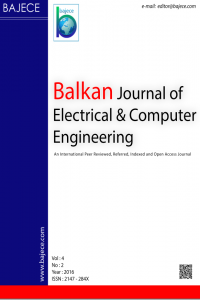Abstract
Double Exponential Smoothing is an improvement of Simple Exponential Smoothing, also known as Exponential Moving Average, which does the exponential filter process twice. It’s usually been used to predict the future data in time series analysis, where there is a trend in the data. In this paper, we aim to introduce a new approach of Brown’s Double Exponential Smoothing in time series analysis. The new approach will combine the calculation of weighting factor in Weighted Moving Average and implement the results with Brown’s Double Exponential Smoothing method. The proposed method will be tested on Jakarta Stock Exchange (JKSE) composite index data. The result of the proposed method shows a promising result in this work.
Keywords
Brown’s Double Exponential Smoothing JKSE composite index time series analysis Weighted Moving Average
References
- [1] OECD: Glossary of Statistical Terms, https://stats.oecd.org/glossary/detail.asp?ID=2708, last accessed on August 19th, 2015. [2] NIST/SEMATECH e-Handbook of Statistical Methods, http://www.itl.nist.gov/div898/handbook/pmc/section4/pmc41.htm, last accessed on August 19th, 2015. [3] Subanar and Suhartono, Wavelet Neural Networks untuk Peramalan Data Time Series Finansial, Program Penelitian Ilmu Dasar Perguruan Tinggi, Yogyakarta: FMIPA UGM, 2009. [4] Boediono and W. Koster, Teori dan Aplikasi Statistika dan Probabilitas, Bandung: PT. Remaja Rosdakarya, 2001. [5] B. Render, R.M. Stair Jr., and M.E. Hanna, Quantitative Analysis for Management, 8th ed., New Jersey: Pearson Education, Inc., 2003. [6] M. Stevenson and J.E. Porter, “Fuzzy time series forecasting using percentage change as the universe of discourse,” World Academy of Science, Engineering and Technology, vol. 27, no. 55, pp. 154-157, 2009. [7] S. Hansun, “Peramalan data IHSG menggunakan fuzzy time series,” Indonesian Journal of Computing and Cybernetic Systems (IJCCS), vol. 6, no. 2, pp. 79-88, July 2012. [8] S. Hansun, “Jakarta stock exchange forecasting using backpropagation neural networks,” Proc. of the 2013 IEEE International Conference on Electronics Technology and Industrial Development, October 2013. [9] A. Popoola, S. Ahmad, and K. Ahmad, “A fuzzy-wavelet method for analyzing non-stationary time series,” Proc. of the 5th International Conference on Recent Advances in Soft Computing RASC2004, United Kingdom: Nottingham, 2004, pp. 231-236. [10] A.O. Popoola, “Fuzzy-wavelet method for time series analysis,” dissertation, Department of Computing, School of Electronics and Physical Sciences, Surrey: University of Surrey, 2007. [11] C. Murphy, “Moving averages,” http://www.investopedia.com/university/movingaverage/, last accessed on August 19th, 2015. [12] S. Dash, “A comparative study of moving averages: simple, weighted, and exponential,” http://www.tradestation.com/education/labs/analysis-concepts/a-comparative-study-of-moving-averages, last accessed on August 19th, 2015. [13] N.E. Hwa, “Different uses of moving average (MA),” http://www.chartnexus.com/learning/static/pulses_apr2007.pdf, lastaccessed on August 19th, 2015. [14] S. Hansun, “A new approach of moving average method in time series analysis,” Proc. of the 2013 IEEE International Conference on New Media, November 2013. [15] incrediblecharts, “Weighted moving average”, https://www.incrediblecharts.com/indicators/weighted_moving_average.php, last accessed on August 19th, 2015. [16] R. Nau, “Moving average and exponential smoothing models”, http://people.duke.edu/~rnau/411avg.htm, last accessed on August 19th, 2015. [17] Yahoo! Finance, http://finance.yahoo.com/q/hp?s=%5EJKSE &a=03&b=1&c=2007&d=06&e=7&f=2015&g=m, last accessed on July 20th, 2015.
Abstract
References
- [1] OECD: Glossary of Statistical Terms, https://stats.oecd.org/glossary/detail.asp?ID=2708, last accessed on August 19th, 2015. [2] NIST/SEMATECH e-Handbook of Statistical Methods, http://www.itl.nist.gov/div898/handbook/pmc/section4/pmc41.htm, last accessed on August 19th, 2015. [3] Subanar and Suhartono, Wavelet Neural Networks untuk Peramalan Data Time Series Finansial, Program Penelitian Ilmu Dasar Perguruan Tinggi, Yogyakarta: FMIPA UGM, 2009. [4] Boediono and W. Koster, Teori dan Aplikasi Statistika dan Probabilitas, Bandung: PT. Remaja Rosdakarya, 2001. [5] B. Render, R.M. Stair Jr., and M.E. Hanna, Quantitative Analysis for Management, 8th ed., New Jersey: Pearson Education, Inc., 2003. [6] M. Stevenson and J.E. Porter, “Fuzzy time series forecasting using percentage change as the universe of discourse,” World Academy of Science, Engineering and Technology, vol. 27, no. 55, pp. 154-157, 2009. [7] S. Hansun, “Peramalan data IHSG menggunakan fuzzy time series,” Indonesian Journal of Computing and Cybernetic Systems (IJCCS), vol. 6, no. 2, pp. 79-88, July 2012. [8] S. Hansun, “Jakarta stock exchange forecasting using backpropagation neural networks,” Proc. of the 2013 IEEE International Conference on Electronics Technology and Industrial Development, October 2013. [9] A. Popoola, S. Ahmad, and K. Ahmad, “A fuzzy-wavelet method for analyzing non-stationary time series,” Proc. of the 5th International Conference on Recent Advances in Soft Computing RASC2004, United Kingdom: Nottingham, 2004, pp. 231-236. [10] A.O. Popoola, “Fuzzy-wavelet method for time series analysis,” dissertation, Department of Computing, School of Electronics and Physical Sciences, Surrey: University of Surrey, 2007. [11] C. Murphy, “Moving averages,” http://www.investopedia.com/university/movingaverage/, last accessed on August 19th, 2015. [12] S. Dash, “A comparative study of moving averages: simple, weighted, and exponential,” http://www.tradestation.com/education/labs/analysis-concepts/a-comparative-study-of-moving-averages, last accessed on August 19th, 2015. [13] N.E. Hwa, “Different uses of moving average (MA),” http://www.chartnexus.com/learning/static/pulses_apr2007.pdf, lastaccessed on August 19th, 2015. [14] S. Hansun, “A new approach of moving average method in time series analysis,” Proc. of the 2013 IEEE International Conference on New Media, November 2013. [15] incrediblecharts, “Weighted moving average”, https://www.incrediblecharts.com/indicators/weighted_moving_average.php, last accessed on August 19th, 2015. [16] R. Nau, “Moving average and exponential smoothing models”, http://people.duke.edu/~rnau/411avg.htm, last accessed on August 19th, 2015. [17] Yahoo! Finance, http://finance.yahoo.com/q/hp?s=%5EJKSE &a=03&b=1&c=2007&d=06&e=7&f=2015&g=m, last accessed on July 20th, 2015.
Details
| Primary Language | English |
|---|---|
| Subjects | Engineering |
| Journal Section | Research Article |
| Authors | |
| Publication Date | September 30, 2016 |
| Published in Issue | Year 2016 Volume: 4 Issue: 2 |
All articles published by BAJECE are licensed under the Creative Commons Attribution 4.0 International License. This permits anyone to copy, redistribute, remix, transmit and adapt the work provided the original work and source is appropriately cited.

